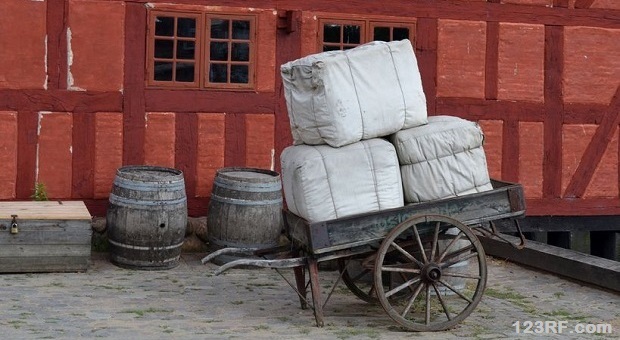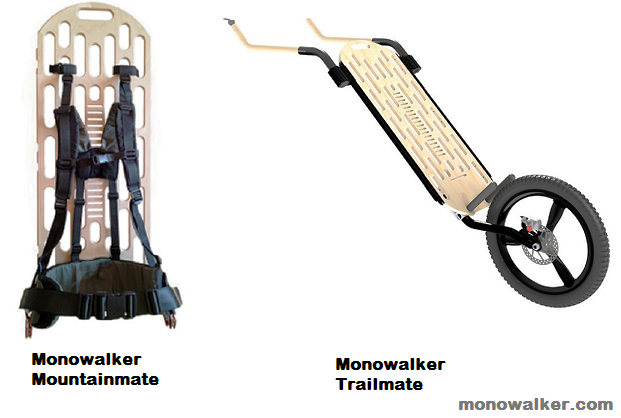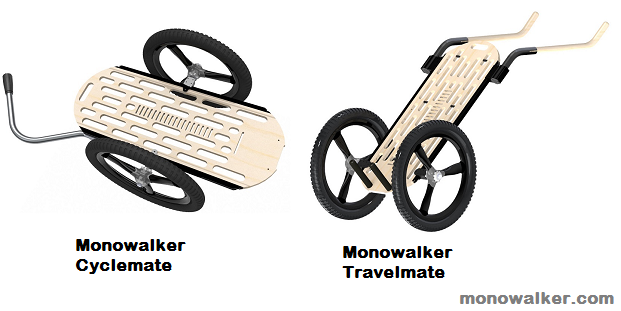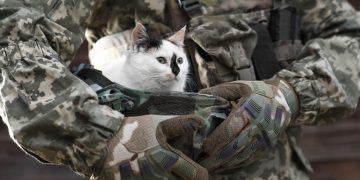 What if you’re bugging out, and you cannot carry as much as you need? What if you’re not healthy enough to lift up your sack, or your beloved ones are too weak and small to carry their bags or even themselves?
What if you’re bugging out, and you cannot carry as much as you need? What if you’re not healthy enough to lift up your sack, or your beloved ones are too weak and small to carry their bags or even themselves?
Depending on the terrain, a cart, sled, trailer, wagon or travois enable groups of foot travelers to carry greater loads with less strain, thus to travel a greater distance each day of travel.
These tools can give you the mechanical advantage to transport loved ones who can’t walk fast enough or far enough. They can also free people of a large percentage of their burdens so that they can walk further.
Pioneer Hand Cart
This is a voluminous two-wheeled hand cart (that sometimes sports a small shelter like a miniature covered wagon) with handles in the front and rear. It can be pushed and pulled by two or more people instead of draft animals.
Many Western pioneers who were too poor to afford covered wagons constructed handcarts and used them to cross the Great Plains to the Western US. Some of my ancestors made use of this method to head West.
Why is this so great?
- Can move large payloads of up to 1200lbs or more
- High ground clearance
- Good for families with children and groups without draft animals
- Doesn’t require the daily chores, maintenance, cost, and large acreage zoned for livestock needed to keep horses, pack animals or draft animals
- Well-built handcarts with watertight wood, fiberglass or metal beds can be used to ferry people and supplies across rivers.
{adinserter emp}Travois
The travois is essentially an isosceles triangle lashed out of timber poles such that it can be pulled by humans or hitched to dogs, horses or other pack animals to haul anything from supplies and teepees to people who can’t walk.
It was used to great effect by Native Americans and French fur trappers. Its advantages are:
- Simple to improvise as long a long poles, cordage and a saw blade or an axe are available.
- Slides best in snow, mud, forested or grassy terrain.
- Less efficient than wheeled options.
- Able to slide over terrain and obstacles that can be difficult for wheeled transport.
Monowalker Mountainmate Universal Pack Board
When using this tool, most of the weight is supported on your hips.
- Carries 45-120liter volume, and payloads up to 100lbs or more.
- 6.6lbs before rucksack or waterproof duffel and worth every ounce – ultra-light and strong formed hardwood wood construction.
- Two pegs for a storage shelf and abundant, universal lashing or strapping points allow secure carriage of ammo cans, big game quarters and 5 gal water and fuel containers by any product in the Monowalker line.
- Universal attachment slots allow the attachment of endless varieties of packs and waterproof, ultralight and durable Ortlieb duffel bags to the pack frame.
- Make sure to carry your survival knife below the pack attached to your trouser belt with a dangler and your core survival gear distributed in your pockets or in a dangled belt pouch so you always carry them even if you doff your pack
- A MOLLE II fighting load carrier, MOLLE II tactical assault panel, MOLLE vest, commercial non-tactical front packs (that won’t stand out in urban environments) or concealed carry jacket offerings with internal Velcro loop attachment surfaces (such as 5.11’s Backup Belt System) help balance the load of your pack and place handguns, magazines, IFAKs (individual first aid kit), OC spray, optics or admin panels out in front where it is more easily accessible without doffing your pack. This same setup works with all configurations of the Monowalker.
- Long guns can be carried with their weight on the padded hip belt and put into action very quickly using products such as the Kifaru Gunbearer.

Monowalker Trailmate One-wheeled Hiking Trailer
This is available as either a complete hiking trailer or a conversion kit that converts the pack frame or any of the other Monowalker products into a nimble, high-tech hiking trailer for traveling hiking trails or cross country.
- Carries 110-140liter waterproof volume, or 100lbs payload.
- 60% of the load to the wheel reduces felt weight of a 100lbs load to a much more manageable 40-50lbs.
- 13.23lbs before rucksack or waterproof duffel – ultra-light and strong wood and aluminum construction.
- The pack board forms the cargo bed.
- Connects to the waist belt of the harness system from the Mountainmate pack
- Two lightweight shaped blonde hardwood handles attach to the pack frame providing leverage to steady the load, reduce vibration while staying warm in winter and cool in summer.
- Ultra-light thumb actuated bicycle break on one of the handles securely stops the tri-spoke aluminum mag wheel on slopes allowing you to stop and rest while hiking uphill and keeps the trailer from pushing you on downhill stretches
- You can still wear a “combat light” load in case you have to doff the trailer with the two QD shackles and make a run for it
- An ultra-light aluminum extension connects the wheel to the bottom of the trailer frame affording ground clearance, superior mobility even in rocky terrain and allows the trailer to traverse obstacles and ford shallow streams
- A GPS can easily be attached to one of the handles in a perfect position for navigation with a mounting bracket, Strac Strapz, Velcro One-wrap or Velcro/Spandex hybrid straps
- With the brake applied to the wheel, a short, light ski can be strapped to the bottom of the tire, turning the hiking trailer into a snow sled
Find out more about bugging-out on “Conquering the Coming Collapse”.
Monowalker Travelmate Two-wheeled Travel Hand Cart/Dolly
This is available as a complete cart or a conversion kit that turns any other Monowalker product into a two-wheeled travel cart perfect for traveling road on foot.
- Carries 110-140liter volume, or 100lbs payload.
- 13.23lbs before rucksack or waterproof duffel – ultra-light and strong wood and aluminum construction.
- 80% load transfer to the wheels reduces the felt weight of a 100lbs load to a mere 20lbs allowing weaker group members to carry a 400% greater load.
- Perfect for paved roads, dirt roads and even many hiking trails since the aluminum tri-spoke mag bicycle wheels and tires offer several inches of ground clearance unlike a dolly.

Monowalker Cyclemate 2-wheeled Bicycle Trailer
This is available as a kit to convert any of Monowalker’s other products to a stable, efficient 2-wheeled bicycle or Motoped trailer or as a completed bike trailer.
- Carries 110-140liter volume, or 100lbs payload.
- 13.23lbs before rucksack or waterproof duffel – ultra-light and strong wood and aluminum construction.
- A variety of universal mounting kits makes the trailer compatible with all mountain bikes and road bikes except bikes with carbon frames
- Carrying the load on the trailer leaving the bike mostly unloaded make the bike or Motoped much easier to ride up hill and much more maneuverable.
- 2-wheeled design allows more than twice the payload of one-wheeled bike trailers and eliminates shearing forces.
Saving Back, and Saving Lives
Carrying your SERE gear in your pockets and your suspending your sheath knife from your trouser belt on a dangler will ensure that those items stay on your person at all times.
Having your group carry a lighter load, just what is needed to fight or survive and using a tool for the rest of your gear will enable you to make better time over greater distance. More, it will increase your carrying capacity and keep you from becoming a casualty of heat or exhaustion.
Once they become exhausted, your people will start making soft compromises. Soft compromises lead to hard compromises and hard compromises get people killed.
Having the group carry the bulk of your load on carts can also reduce the weight carried by your security force. Carrying a heavy load will greatly impair their fighting ability.
So think outside the box and choose one of these tools, because they can enable groups to carry better shelter, more food, and water or force multipliers, improving their chances of survival.
This article has been written by Cache Valley Prepper for Survivopedia.
























































































These are all good ideas. I am suprised game carts were left off the list, but I guess the authors writing would get peoples imagination going about other options as well.
People in Asia and Europe use bicycles, tricycles, wheeled hand carts and even amphibious hand carts for many years.
The North Vietnamese Army and Viet Cong hauled enough ammo, rockets, mortar and artillery shells, anti aircraft guns, medical supplies and food this way through mountainous jungles and swamps, in enough volume to sustain combat against the US military for years.
Absolutely Don! Heavy duty game carts are a great option, especially collapsable models. Heavy duty garden carts and handbuilt carts like the Africart project uses are other options. The purpose of this article was simply to encourage foot travelers to make use of basic technologies that don’t get talked about in enough in preparedness circles. Thanks for reading and commenting!
There are still ruts made by migrating native Americans along most of the Colorado River, especially the California side. Evidently they found it easier to allow the poles to follow old ruts and some of them are extremely deep! In some areas Jeep tracks have almost obliterated them.
Bug out to where??? I have to chuckle every-time I see something like this. Where can we bug out to? A lot of us don’t have Mountains, and forest to run to. Even then, with all the modern tech. what good will that do. They can find a flea on a Camels back now days…let alone a person hiding. So, just where are we going to bug out to? Don’t get me wrong, there is nothing wrong with having a few extras on hand for emergency, but bugging out? I don’t think so…:(
Suez,
In order for a rational person to leave security, shelter and supplies behind there must be a pressing need. But under certain circumstances, chances of survival are clearly improved (for the prepared) by relocating, pre-planned destination or not. (Think tsunami, ethnic cleansing by a vastly superior enemy, or lethal chemical, biological or nuclear threats, to names just a few.)
That said, bugging out without having prepared to do so before hand will turn you into a refugee if you’re lucky, a corpse if you are not. If you do have to bug out, you’re chances of survival will be improved by solid planning and preparation.
I’m sure we are all capable of thinking up situations with extremely low probability of survival, but (to me at least) that’s the domain of the pessimistic, hopeless or paranoid. In my opinion, survival is about improving your odds through competent and realistic planning, preparation and training.
Suez, I can thing of some reasons you might need to bug-out even though you don’t have any place to go. Flood, fire, tornado, earthquake, etc. So while you may not have a preplanned place to go, being able to bug-out maybe necessary.
We are the ones the die first in the movie.
While the Pioneer hand carts are a great idea, they are not readily available.
On the farm/ranch we constantly use a hand cart that will carry 500# easily and balances so that it is simple to push or pull. Northern Tools provides both 2 and 4 wheel carts that work very well for these types of things, some of the 4 wheel carts (looking much like bigger versions of our little red wagon from childhood) will carry up to 3/4 ton.
Check your local farm & ranch supply stores or industrial tools stores… these load bearing carts are worth having!
A very interesting idea! But at about 1,000 USD for the Trailmate …. Well I wonder who has an extra grand for this? I agree with Suez about where do you bug out to?
Laserus,
For me, the Monowalker is the best product I’ve found, “the ideal.” At the other end of the spectrum, the travois might make more sense if you need to improvise something since all you need to build a travois is a cutting tool, some cordage and some poles. I figured most people could afford or improvise that even with very limited resources, skills or imagination.
I’ll include a link to another option that anyone should be able to afford or acquire the materials for and that has very clear instructions to help realize the goal of using skids or the wheel.
Thanks for reading and your comment!
-Cache
http://mercurypoisoningproject.org/malawi/background.html
Any Amish in your area? Amish craftsmen can make a cart to your order that will last 100 years. Price is usually negotiable and always fair.
Excellent option Ed. I’m always pleased to see students of survival adapting the principles of survival to their specific circumstances, abilities, resources, strengths and limitations.
I try to keep a positive, optimistic tone with readers and students, minimize negativity, fear-mongering, criticising, comparing, complaining, contending, competing, ego, pride and the like as people tend to mirror them to the extent that they are reactive or insecure. People do not learn effectively when they are preoccupied with defending themselves. I mention this, because I would some unsolicited advice and want readers to understand that the spirit in which I offer it has nothing to do with any of those things. I offer it simply to help any readers who could benefit from it become more effective at survival.
For some time now, the survival community has benefited from an infusion of new blood, talent, experience and synergy. This has been driven by numerous factors such as changes to our planet, greed, politics, economics, world events, the proliferation of information technology, communications technology, connectivity, growing familiarity with social networking media and the increasing popularity of survival-related TV.
Accompanying the opportunities that have come with the increased traffic, I’ve noticed an increase is comments by readers who are disappointed frustrated when ideas or information about survival is presented to them in formats other than bullet points, sound bytes, Cliff notes or other formats written at the readability level that they prefer or even if the information is formatted just so, they are beside themselves if the information isn’t a perfect fit for their specific situation … as if any solution to a survival problem that is not custom tailored to their needs, it’s useless.
These students and readers would do well to take note. Self-reliance, survival, self-defense and related disciplines are all predicated on fundamental principles such as if the USMC mantra to “improvise, adapt & overcome” at their core. As students build proficiency in survival,
they become increasingly more adaptable. When things go sideways, you won’t have access to professors, advertisers, experts, advisors and instructors to adapt the principle of survival to your specific situation. You won’t likely have access to legions of professional instructors via the internet to provide you with free consulting services, take into account your every budgetary constraint, weather condition, deficiency, hurt feeling, phobia or lifestyle choice and spell out the solution to problems or roadblocks. It won’t matter whether the obstacle you perceive is as real as it gets or if it’s of your own manufacture and exists only in your mind. The end result will be the same.
Under the best of circumstances, life is not fair. Under gravest circumstances, life is far, far worse than “not fair.” If money is an insurmountable obstacle to you, some piece of high-speed equipment that be ideal for someone else, might not be the best choice for you. If you can acquire high-speed gear, that’s great. If not, adapt. In this case, adaptation shouldn’t too terribly difficult since the article and readers mentioned many other options, including a travois, that you can make with a little cordage and three or four poles. If you can’t come up with cordage, use pegs … or radio flyer wagon or a garden cart or a pioneer handcart or an Amish handcart or an AfriCart or a bicycle. Any number of solutions could fill the need. It might have a handbrake for hills or be as good in the snow and so on. The idea is to harness one or more basic laws of physics to help your group’s security element from becoming exhausted, making compromises and getting killed or enable a lone, long distance traveller to carry enough water to make it from one year-round spring to the next in an arid Western state or enable s survivor with a back injury to make a journey on foot that would not otherwise be possible.
Consider the relative ease in obtaining supplies in the USA right now while resources are abundant vs during desperate times such as warfare, disaster, lacking electricity, fuel or without food, weapons, currency, employment, transportation or similar circumstances.
I’m with Suez above. Today, if “they” really want to find you, technology exists for them to do so. I’d rather stay home, where my perimeter is fully protected, where nmy stocks of food, water, medical supplies, weapons and ammunition are readily available. I even havce emergency supplies of food for my dogs, for which too many people forget to provide. Bugging out to the “outback” only limits me to what I can transport on my own…..and believe me when I say….WATER IS HEAVY, as are canned (preserved) foods. As prepared, I am ready for an extended stay.
Suez,
Obviously you don’t live near a nuclear power plant or even on the Pacific coast where danger of high levels of radiation would cause people to “bug out”. What if a volcano erupted or an earthquake or tornado caused the loss of your home? All good reasons to bug out. Having a bag ready to get you to a relatives house or other safe place is always a good idea.
JM
After reading your article I found that I am not prepared to BUG_ OUT ! So I decided to go and buy a few things , ended up with the worst bug out bag ever. Then I went to the sport store and looked around . Following your advice I bought food ,water, cooking stove , pot to cook in, and plenty of personal items.
Then I took one of my .45’s with 250 rounds of ammo and put it in the bag. This bug out bag is the best for the cost was about $350 for every thing. I do not plan to walk for I need to drive . I can make to my safe place in three hours. I can hide there and wait it out and watch from where I am. If I see any one coming my way then I will move , or shoot the intruders .
That would be OK, as long as we have electricity!! But, if the electric grid is off, what then? I think we can safely say, that at some point the grid is going to be shut down, whether by the higher ups, or attack from another country. To say the least, your car or vehicle wouldn’t run…:) So plan on a long hike!!! 🙂
If and when the grid goes down – those who live close to a river might want to start thinking about what is going to happen to all the damns up river. Bugging out may not be an option.
Glad to hear that you’re preparing Ramon! Do what you can to ensure that your vehicle will get you to your hidey hole. If you can safely store enough stabilized fuel to get you there, I would make that a priority along with everything else you can do (within reason) to keep your vehicle operational. But also plan, prepare and train a backup plan as Suez suggested. If foot travel is especially difficult in your situation for some reason, your chances of preparing a viable alternative means of transport will be greatly improved using the resources that are available to you now, before an emergency. Don’t be afraid to think outside the box to solve your problem.
Thanks for reading and commenting!
-CVP
Nobody knows what events are going to lead to the necessity for a “Possible” bugout scenario. However, history has shown this type of need to become nomadic has happened to many societies time and time again. The US has not truly ever seen this – YET…. If things get that bad you better believe that leaving your “Fortress” as some of these amateur preppers want to think they have is the best idea under the sun. Most that have guns and ammo to protect themselves and their families are more of a danger than a protector. Without the extensive training needed they’ll probably shoot themselves in the leg or a family member before a motivated, starving gang member that has no moral compass raiding their property with dozens of cohorts. Yes heading out of town in even the most urban areas makes sense. You might not make it to the mountains but it’s better to be in a sprawling area outside of the more densely populated urban ones is better just until things shake themselves out. Just an opinion, but it comes from experienced experts not just watching TV or reading books.
For those of you who recognize my monicker, it may seem to you that i usually post a criticism or counterargument. It only seems that way as most of the many blogs on this site are well done, with the result being that I need not respond at all, as nearly every blog has a slew of “Atta-boys” already. But in this case, I must respond.
While I find this site full of usefull articles, I seldom find one that zeroes in on a subject about which I genuinely need more information. So, to Cache and the folks at Survivopedia, I say “Bravo!”
The criticisms above are to a degree warranted. True, a grand for one the trailmates described my seem like a lot to most of us, but the idea of a luggable device over rough terrain for those of us who are older, weaker or infirmed is quite helpful. I’d bet a similar device could be bought, adapted or built for a reasonable amount for perhaps a lighter load.
I don’t believe any of these devices are for really heavy loads out in the wilderness, if your bug out location is not to be detected. The weight alone would make their use trackable. Probably great for moving large loads to or around a location prior to a meltdown…or perhaps useful moving an immobile person with some adaptation.
You have overlooked a tried and proven transport item that is readily and cheaply available: the bicycle. In Vietnam, the NVA and Viet Cong moved tons of weapons and ammunition long distances strapped to bicycles in very nasty terrain. And once at your destination you can go back to riding it.
Thanks Osito! I’m an avid student of self-reliance. I’ve been researching for decades and have noticed that much of the same information gets recycled and regurgitated on survival sites so I try to write about (what are to me) original ideas or ideas that don’t get enough coverage.
I’ve studied how various cultures have solved this same problem such as the pioneers and ranchers of the American West, Native Americans, other nomadic tribes and guerrilla campaigns like M mentioned about the Vietnamese using bicycles. It seems like most survivalists stick to US infantry doctrine which only works if you have a huge logistics train to move gear and everyone is fit enough to carry a “combat heavy” or “existence” load which is not realistic for most survivalists using more of a family or tribal group structure.
Most nomadic tribes that have a need to defend themselves use a supply train with some kind of travois or carts. It doesn’t have to be the one that works for me. I posted a link to the Malawi Afri-cart project that anyone can afford or acquire supplies to build.
For groups, breaking out the security and scout elements from the supply train keeps them fresh, only carrying a “combat light” load. The rest of their gear should be on the carts. Most people won’t stay alert and in any condition to fight for long carrying excessively heavy loads. If you’re very concerned about security (and you should be) E&E and combat counter-tracking tactics will go a long way toward keeping your group secure: moving only in darkness and foul weather, wearing the same tread pattern, using “Cat’s Paws”, stepping in each others foot prints, not following a fixed bearing too long, staying of major lines of drift, affixing brush behind your wheels to obliterate your tracks, having the last person sanitize the trail, maintaining noise, light & scent discipline etc.
Thanks for everyone reading and commenting!